Sequel of the preceding post The Warped Science of Interstellar (5/6)
In november 2014, the Hollywood blockbuster and science-fiction movie Interstellar was released on screens and much mediatic excitation arose about it.
This is the last one of a series of 6 posts devoted to the analysis of some of the scientific aspects of the film, adapted from a paper I published last spring in Inference : International Review of Science.
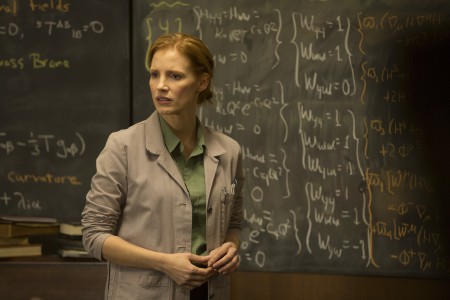
The final equation
At the very end of the film, the scientist’s character called Murph begins to write an equation aimed to solve the problem of the incompatibility between general relativity and quantum mechanics. We can see blackboards covered by diagrams and equations supposed to be a possible way to the « ultimate equation » of a so-called « Theory Of Everything ». If discovered by the scientists, it would eventually help to solve all the problems of humanity. I will not discuss the naivety of such a view, but briefly discuss the question whether the equations on the screen have any meaning.
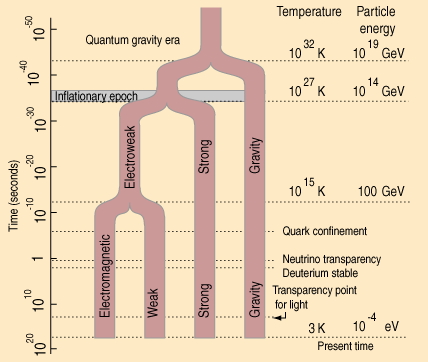
At first sight we can doubt because the unification of general relativity and quantum mechanics remains unsolved – even if various approaches, such as the loop quantum gravity[1], the string theory[2] (of which the Randall-Sundrum model referred above is a very particular solution) or the non-commutative geometry[3], are intensively explored by theoretical physicists all around the world.
Clearly the Interstellar filmmakers have bet on the most « fashionable » attempt for unifying all fundamental interactions : string theory. String theory stipulates that the fundamental constituents of matter are not point-like particles but open or closed strings on the scale of the Planck length (10-33 cm), whose vibrational modes define particle properties. In this framework, space-time becomes a derived concept, which only makes sense at a scale larger than that of the strings. String theory, which comes in five different varieties, aroused such keen interest that in the 1990’s, certain theorists believed it was capable of giving a « Theory Of Everything ». However, the mathematical difficulties involved are formidable, and it is not certain that they will be resolved in the future[4].
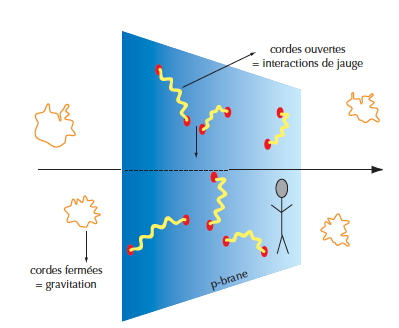
The five different string theories have given birth to a larger supposed theory, of which the string theories would only be limits : not only one-dimensional lines could vibrate, but also two-dimensional surfaces and other spaces of higher dimension, such as membranes – from whence the name M-theory given to this hypothesis.
Returning to the ultimate equation briefly seen in Interstellar on Murph’s blackboard, something looking like

as far as I can remember, physicists who know a little bit of string theory will recognize the so-called effective action of M-theory in the lowest approximation of its perturbative development. In simpler terms, it gives a hint of what would like the « ultimate equation » of physics if M-theory was the correct framework. It is probably not, but I imagine that Kip Thorne made a clin d’œil to string theorists to mean that, in his opinion, a future Theory of Everything will probably be similar to M-theory. I do not share this point of view, but it is rather unexpected to find such a sophisticated message in a Hollywood movie.
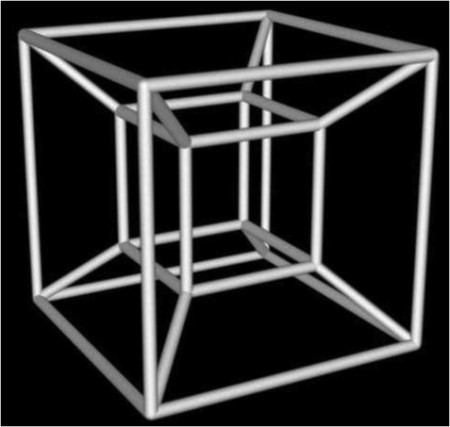 The g5 and d5x terms mean that we deal with a theory in 5 dimensions : 1 for time and 4 for space, like in the Randall-Sundrum case. In a 4-dimensional space without curvature, the analog of the cube is called an hypercube or a tesseract. The tesseract is to the cube as the cube is to the square. Just as the surface of the cube consists of 6 square faces, the hypersurface of the tesseract consists of 8 cubical cells, giving a visual effect which has been excitingly represented in Interstellar.
The g5 and d5x terms mean that we deal with a theory in 5 dimensions : 1 for time and 4 for space, like in the Randall-Sundrum case. In a 4-dimensional space without curvature, the analog of the cube is called an hypercube or a tesseract. The tesseract is to the cube as the cube is to the square. Just as the surface of the cube consists of 6 square faces, the hypersurface of the tesseract consists of 8 cubical cells, giving a visual effect which has been excitingly represented in Interstellar.
But for my part, from an artistic point of view, I am much more moved by the Corpus Hypercubus painted in 1954 by Salvador Dali. The Spanish artist depicted the cross of crucifixion as a tesseract to signify that, just as God could exist in a space which is incomprehensible to the humans, the hypercube exists in four space dimensions which are equally inaccessible to ordinary minds.
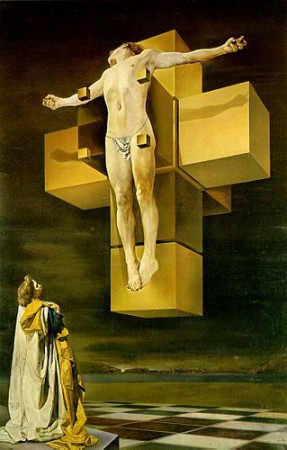
Denouement
Released some months before Interstellar, the science fiction thriller Gravity was lauded for its impressive depictions of weightlessness and the hostile nature of space[5]. Most of the science shown in Gravity could be understood in the framework of Newtonian theory, published more than 400 years ago. In sharp contrast, understanding most of the phenomena depicted in Interstellar requires some understanding of general relativity, along with quantum mechanics, and even a little bit of string theory. The result is an intriguing and noteworthy film, one that attempts to combine a great story and accurate science.
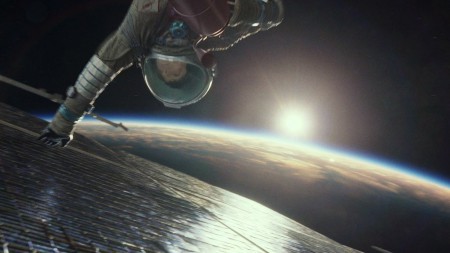
But Interstellar is a work of science fiction. Artistic license and scientific extrapolation are part of the game. Assessing the point at which science gives way to science fiction is a worthwhile educational endeavour all by itself.
REFERENCES
[1] C. Rovelli : Loop Quantum Gravity, Living Reviews in Relativity 1 (1998).
[2] M. Green, J. H. Schwarz, E. Witten : Superstring theory, Cambridge University Press (1987).
[3] A. Connes : Non-commutative geometry, Boston : Academic Press (1994).
[4] P. Woit : Not Even Wrong: The Failure of String Theory And the Search for Unity in Physical Law. New York: Basic Books (2006).
[5] Gravity, réalisé par Alfonso Cuarón, Warner Bros Pictures film (2013).
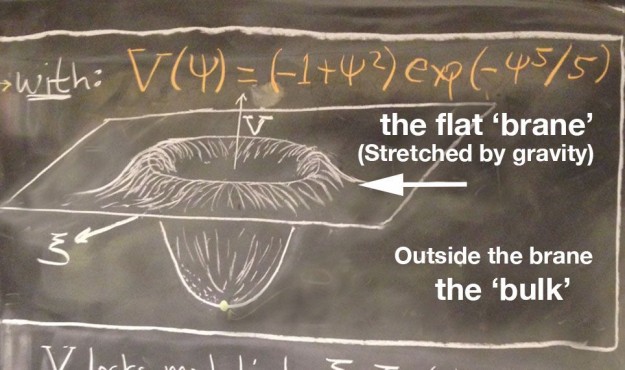
It may be of interest that a five-dimensional theory of gravity does not have to be the M theory. The oldest of such theories is the Jordan model from the early 20th century. This is a model equivalent to the Brans-Dicke model, which is a generalisation of Einstein’s theiry coupled to a scalar field. These (JBD theories) are foundations of the later appearing string theories.
In the JBD theory, the 4th space dimension is compactified. Velovity in it is related to e/m, and hence to electrical charge.
Thank for your comment, I agree with you.